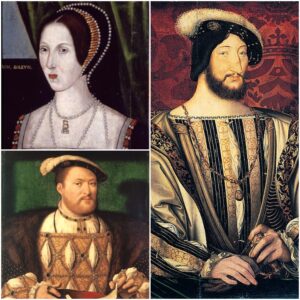 On this day in history, Sunday 27th October 1532, Henry VIII and Francis I, the Kings of England and France, dined together at a special “great banquet” in Calais. Chronicler Edward Hall records that “The French kyng was serued iii. courses, & his meat dressed after the French fashion, & the kyng of England had like courses after thenglishe fashion, the first course of euery kyng was. xl. dishes, the second. lx. the third. lxx. which wer costly & plesant.” So, the first course “of every king” was 40 dishes, the second 60 dishes and the third 70 dishes – wow!
On this day in history, Sunday 27th October 1532, Henry VIII and Francis I, the Kings of England and France, dined together at a special “great banquet” in Calais. Chronicler Edward Hall records that “The French kyng was serued iii. courses, & his meat dressed after the French fashion, & the kyng of England had like courses after thenglishe fashion, the first course of euery kyng was. xl. dishes, the second. lx. the third. lxx. which wer costly & plesant.” So, the first course “of every king” was 40 dishes, the second 60 dishes and the third 70 dishes – wow!
The feast was followed by a masque; it was time for Henry VIII’s sweetheart to make her entrance. In The Maner of the tryumphe of Caleys and Bulleyn, a contemporary source printed in 1532/3 by Wynkyn de Worde, it gives the following account:
“And after souper there came in a maske my lady marques of Penbroke [Anne Boleyn} my lady Mary [Carey] my lady Darby my lady Fitzwater my lady Rocheford my lady Lislie and my lady Wallop gorgyously apparayled with visers on theyr faces and so came and toke the frensshe kynge by the hande and other lordes of Fraunce and daunced a daunce or two. And after that the kynge toke of theyr visers and than they daunced with gentylmen of Fraunce an houre after.”
Edward Hall describes what the ladies were wearing:
“After supper came in the Marchiones of Penbroke, with. vii. ladies in Maskyng apparel, of straunge fashion, made of clothe of gold, compassed with Crimosyn Tinsell Satin, owned with Clothe of Siluer, liyng lose[loose] and knit with laces of Gold: these ladies were brought into the chamber, with foure damoselles appareled in Crimosin satlyn[satin], with Tabardes of fine Cipres[cypress lawn] […]”
Hall also describes how the room was lavishly decorated with cloth of tissue, cloth of silver, gold wreaths decorated with stones and pearls, and candelabra. It also had a cupboard stacked high with gold plate. He notes “To tell the riches of the clothes of estates, the basens & other vessels which was there occupied, I assure you my wit is in sufficient.” It sounds like an amazing spectacle.
Hall goes on to say that Anne danced with Francis I, the Countess of Derby danced with the King of Navarre, and the other ladies each took a lord. Then Henry VIII removed the ladies’ visors to show off their beauty. The French king then conversed with Anne Boleyn before retiring to his lodgings, escorted by Henry VIII. Hall notes that the Duke of Norfolk entertained the nobles of France “with many goodly sportes and pastymes.”
Click here to view a timeline of the events of October 1532 and to read more about Henry and Anne’s visit to Calais.
Notes and Sources
- Hall, Edward (1809) Hall’s chronicle: containing the history of England, during the reign of Henry the Fourth, and the succeeding monarchs, to the end of the reign of Henry the Eighth, in which are particularly described the manners and customs of those periods. Carefully collated with the editions of 1548 and 1550, p.792-793.
- ed. Goldsmid, Edmund (1884) The Maner of the tryumphe of Caleys and Bulleyn and The noble tryumphaunt coronacyon of Quene Anne, wyfe unto the most noble kynge Henry VIII, Wynkyn de Worde (1532-3), p.14.